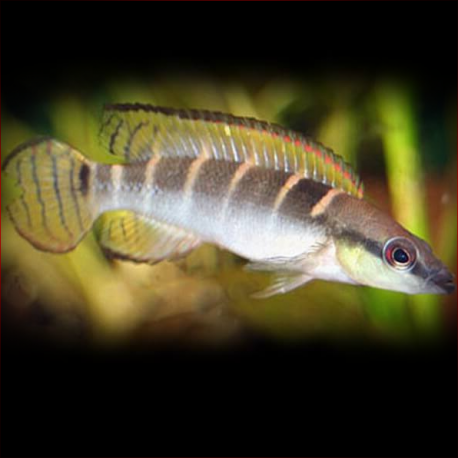More info
Datasheet
| Minimum Tank Size | 160 litres / 42.27 US gallons |
| Maximum Size | 7.6cm / 2.99inches |
| Temperature | 24°C / 75.20°F - 27°C / 80.60°F |
| Hardness | 2-8ºdH |
| pH | 5.0-6.8 |
General Description
Crenicichla compressiceps, also known as the Compressiceps Dwarf Pike Cichlid, are relatively small fish with a maximum size of 7.6cm. They are lively swimmers and require larger aquariums compared to similar-sized fish due to their activity levels. These fish are visually appealing and relatively easy to care for, often sought after for breeding purposes.
Aquarium Setup
To house Crenicichla compressiceps, a tank of at least 160 liters is recommended. The tank should have ample hiding spots, such as wood pieces and scattered leaves on the substrate. While plants can be included, these fish are unlikely to disturb them. Water conditions should be maintained with a pH range of 5.0-6.8, hardness between 2-8 dH, and a temperature of 24-27°C (see table).
Behaviour
Crenicichla compressiceps can exhibit aggressive behavior, particularly towards smaller fish which they may see as prey. It is advisable to keep them with larger, more robust tankmates to prevent any aggression issues. In the wild, these fish primarily feed on insects, displaying good night vision for hunting. They can also be territorial, especially during breeding periods.
Feeding and Diet
Tank-bred Compressiceps will accept a variety of foods, including live and frozen options. Wild-caught specimens may require live or frozen foods, with earthworms, mealworms, and crustaceans being ideal choices. Maintaining a diverse diet is crucial to prevent health issues like hole-in-the-head disease.
Reproduction & Dimorphism
Breeding Crenicichla compressiceps can be challenging without target fish in the aquarium to diffuse aggression and aid in pair bonding. Conditioning the pair with high-quality live or frozen foods is essential. Females may develop a reddened belly before spawning, with courtship involving a unique head-down shaking dance. Males can be distinguished by their striped yellow fins. These fish are cave brooders, laying around 25-50 eggs per clutch, with fry hatching within days.
Habitat and Distribution
Crenicichla compressiceps are found exclusively in the lower Rio Tocantins basin in Brazil. Their natural habitat consists of this river basin, showcasing their adaptability to the specific environmental conditions present in this region.

